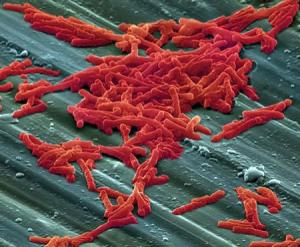Oct 12 2015
Robots are capable of all sorts of tasks to help better treat cancer: They connect oncologists to patients remotely, make incisions, staple them shut, deliver "nano" therapies--and they clean rooms. New research from Penn Medicine infection control specialists found that ultraviolet (UV) robots helped reduce the rates transmission of the common bacterial infection known as Clostridium difficile among cancer inpatients - mostly blood cancer patients, a group more vulnerable to hospital-acquired infections - by 25 percent. The interventions also saved about $150,000 in annual direct medical costs.
 New research from Penn Medicine infection control specialists found that ultraviolet robots helped reduce the rates transmission of the common bacterial infection known as Clostridium difficile among cancer inpatients -- mostly blood cancer patients, a group more vulnerable to hospital-acquired infections -- by 25 percent. The interventions also saved about $150,000 in annual direct medical costs.
New research from Penn Medicine infection control specialists found that ultraviolet robots helped reduce the rates transmission of the common bacterial infection known as Clostridium difficile among cancer inpatients -- mostly blood cancer patients, a group more vulnerable to hospital-acquired infections -- by 25 percent. The interventions also saved about $150,000 in annual direct medical costs.
The data is being presented at the annual ID Week meeting by David Pegues, MD,, a professor of Infectious Diseases in Penn's Perelman School of Medicine and a healthcare epidemiologist in the Hospital of University of Pennsylvania's Infection Prevention and Control (Abstract #1715).
Several new cleaning tactics--on top of all the scrubbing, mopping, spraying, and wiping performed by Environmental Services (EVS) professionals--have been implemented at hospitals across the U.S to help reduce transmission of such infections, but which new methods are the most effective and practical has remained unclear.
UV robots flash UV lights across the room to lock onto DNA of organisms and kill them.
"There weren't a lot of studies showing the efficacy of UV lights to clean hospital rooms," said Pegues, who co-authored a recent study that found a lack of evidence for best methods for cleaning hospital rooms. "These results help fill that gap. This is a cost-saving measure that showed a sizeable reduction in infections for a high-risk group of patients--and set the stage for further implementation of the technology at our hospitals."
The team found that using a ultraviolet germicidal irradiation robot after a room cleaning by EVS not only reduced the number of infections in cancer patients compared to the year prior with no robot, but did so without adversely impacting room turn around. They also report that infections increased by 16 percent on units without the robot during the study period.
C. diff aren't as deadly as other bacteria, but they are harder to clean away. They forms spores that are resistant to many disinfectants and can persist in the hospital environment for months. Approximately 500,000 people contract C. diff while in the hospital every year in the U.S., and nearly 15,000 die directly from the infection. Cancer patients, whose immune systems may be compromised from stem cell transplants and/or chemotherapy, are more susceptible to infections than other inpatients.
In 2013, the number of cases of C. diff on the cancer units studied at Penn were five times the rate of all the other units in the hospital combined, despite targeted evidence-based interventions and EVS process improvements, including the use of bleach for daily and terminal room cleaning of C. diff rooms.
For the study, the researchers compared C. diff rates from that year to rates in 2014 (when the robot was deployed). The vast majority of the patients on these oncology floors were being treating blood cancers, including leukemia and multiple myeloma.
During 2014, the researchers used the ultraviolet robot for 21.1 percent of all patient discharges (542 out of 2,569 total patient discharges) on three study units (about 10 deployments for a week). Following cleaning of the room by EVS, the robot was deployed for two eight-minute cycles on either side of the patient bed with the bathroom door left open.
The researchers compared the rates of C. diff, and found a 25 percent reduction in cases during the 52-week intervention period versus the baseline period, 2013. There were 87 cases of C. diff on the study units in 2013, and 66 in 2014.
Some modalities, such as the hydrogen peroxide vapor system, can take up to two hours. Surprisingly, this intervention did not impact room turnaround. The mean clean time was roughly the same, approximately 36 minutes. Although no additional EVS staff was used during the evaluation, improving and spreading use of UV light for disinfection requires hiring additional EVS staff.